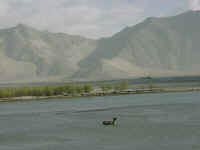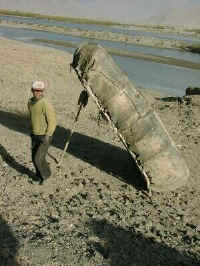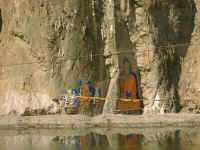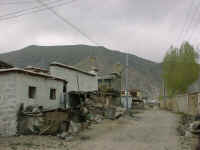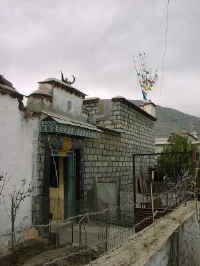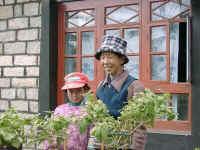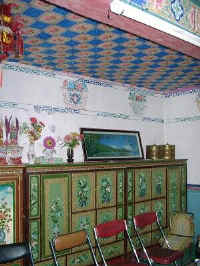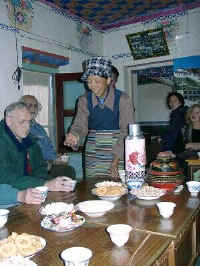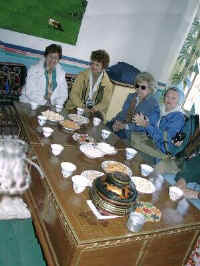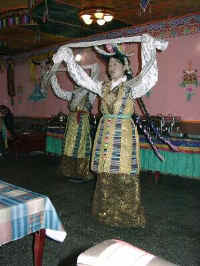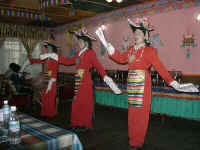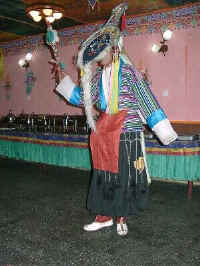|
TIBET Sunday, 16 April. We were up at 4:15 and down at the breakfast buffet at 4:50, as instructed. The problem was that the hotel was just beginning to set up the buffet, and there was very little out yet. The bus left for the airport at 5:30. We took a 6:45 flight to Lhasa. Again, it was a very pleasant flight (even though it was completely full) and right on time. We landed in Tibet at 8:40 and were met by Tashi, our local guide who, pursuant to Tibetan custom, presented each of us with a long white scarf (hada) as a token of esteem and good luck. That's also when we learned that the airport for Lhasa isn't even in the same province as the city. Even though Lhasa is only 20 some miles away, it's a 60-mile drive (two hours) to get there because there is no bridge over the Yangtze River on a direct route. We had to drive 20 miles upriver, then 20 miles back down on the other side. We began to appreciate that traveling in Tibet was going to be very different. After several miles, the bus stopped along the road where a man was waiting for us with his yak skin boat pulled up on shore. There were a couple of other boats out on the river with the high mountains as a backdrop. It certainly was beautiful. Our brochure had promised us the opportunity to ride in the boat, but it was not to be. They had discontinued the practice after some German tourists capsized the boat and drowned. So we only got to examine the boat on shore. Later, on the other side of the river, we stopped again to see a Buddhist shrine consisting of figures painted on the rock. According to Tashi, the shrine dated from the 7th century, but the painting was clearly very recent. We saw several farms along the way, some with yak or horse drawn plows, but never any machinery. Tashi told us that the river was important to the custom of "water burial," still practiced by most Tibetan families who live near the river. When a person dies, the body is cut into pieces by a specially trained expert, and the pieces are thrown into the river. If the expert is not available, or the family can't afford to hire him, the whole body is thrown into the river. Just think about it! All of China is downstream from Tibet. [This is similar to "sky burial" in which the cut-up pieces of the body are laid out to be devoured by vultures.] We got to the Tibet Hotel in Lhasa at 10:45. We were immediately served yak butter tea in our room. (We didn't care for it.) The hotel was modern looking but lacked many modern amenities. For example, we found there was no central heat. However, they brought us a very efficient electric heater that kept the room quite comfortable. The electricity occasionally went off, and there often was no hot water. Most noticeable though, the halls, lobby and other common area were unheated and freezing cold, usually colder than the air outside. Worst of all, the food at the hotel was terrible, and we ate almost all our meals there. The Tibetans are not the same race as the Chinese. Their origins are entirely different, and their skin is much darker (perhaps from the sun). Lhasa seemed very poor and run down compared to the Chinese cities we had visited. Of course, it is much smaller with a population of 150,000 versus several million in those other cities. The main streets are wide and well maintained, but most of the side roads are unpaved and very rough. We saw cattle being herded down the main streets. There are no tall buildings. There are a cement factory and a brewery, but very little other industry. The surrounding farms produce only a small amount of wheat and barley. Consequently, almost everything else has to be brought in from Chengdu, either by plane or by truck. The trip by road takes three days each way. (A railroad from Chengdu to Lhasa was completed in 2006, cutting the travel time to eight hours.) Our group met at 5:00 p.m. and the bus took us for our visit to a Tibetan home. The dirt road outside and the exterior wall of the house were not very attractive. We could see a yak skull over the entrance and five small flags flying above a corner of the house (blue=sky; white=clouds; green=water; yellow=earth; red=fire), in keeping with the almost universal Tibetan tradition. As we passed through the front gate, we found ourselves in a large courtyard. The house, seen from here, was quite pretty. Inside we found a brightly decorated room with a long, low table set with snacks. After we sat down, our hostess poured the traditional butter tea. With Tashi acting as interpreter, we asked her questions about her house and life in Tibet. Her house, with several rooms, was larger than average. It had electricity but no running water. There was a hand pump in the courtyard. There was a wood stove for cooking, but the house had no heat (not even in winter). Surprisingly, the winter temperature on the Tibetan Plateau (as opposed to the mountains) seldom gets below the mid-20's. Most Tibetans bathe only once a year, a ceremonial bath in the river. Yet we never noticed a trace of body odor, even later when pressed tightly against Tibetans in their shrines. After a brief stop at our hotel, the bus took us to the Mad Yak Restaurant. Our buffet dinner included yak stew. After the meal there was a floorshow, referred to in our schedule as "Tibetan Opera." It consisted of dancers in ceremonial Tibetan costumes and masks. We were back at the hotel by 8:00 p.m. It was still very light outside. All of China has the same time zone. Because Tibet is so far west, its "sun time" is about two hours behind the official time. It had been a long day, and we were glad to get to bed early.
Copyright © 2000-2023 DarrellPeck.com All rights
reserved. |

